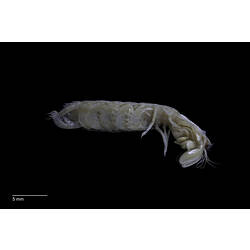General Description
Eye with subglobular cornea. Rostral plate broadly quadrate with apical spine. Antennal protopod with 2 mesial and 1 ventral papilla. Last segment (dactylus) of raptorial claw with 8-11 teeth. Pereopods 1-2 basal segment with inner and outer spine; pereopod 3 with outer spine only. Abdominal somite 6 with 2 ventrolateral spines anterior to uropod articulation. Tailfan (telson) with low median prominence terminating in acute spine; lateral proximal margin without distinct semicircular lobe; intermediate denticles elongate, triangular. Up to 4.5 cm.
Biology
Slender Mantis Shrimps seldom leave their burrows and are ambush predators that feed on passing soft bodied prey such as small fish, cephalopods and shrimps. Consequently they are less frequently encountered than other species which actively forage. The common name stomatopod is sometimes used, after the Order Stomatopoda to which they belong.
Distribution
Southern temperate oceans, including southern Australia.
Habitat
Shallow, soft substrates, to 110 m depth.
More Information
-
Animal Type
-
Animal SubType
-
Brief Id
Mantis Shrimp with well armed front legs, independently mobile eyes and spiky tail plate; with 8-11 teeth on finger of raptorial claw.
-
Maximum Size
4.5 cm
-
Habitats
-
Diet
Carnivore
-
Endemicity
-
Commercial
No
-
Conservation Statuses
DSE Advisory List: Not listed, EPBC Act 1999: Not listed, IUCN Red List: Not listed
-
Depths
Shallow (1-30 m), Deep ( > 30 m)
-
Water Column Locations
On or near seafloor
-
Taxon Name
-
Scientific Author
(Hale, 1924)
-
Common Name
Slender Mantis Shrimp
-
Phylum
-
Subphylum
-
Class
-
Subclass
-
Order
-
Family
-
Genus
-
Species Name
osculans




